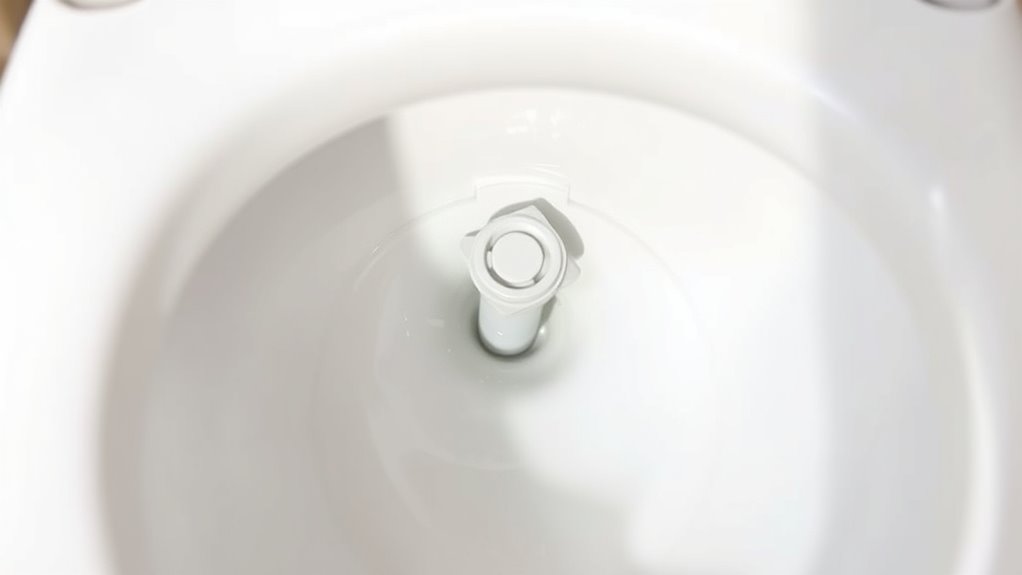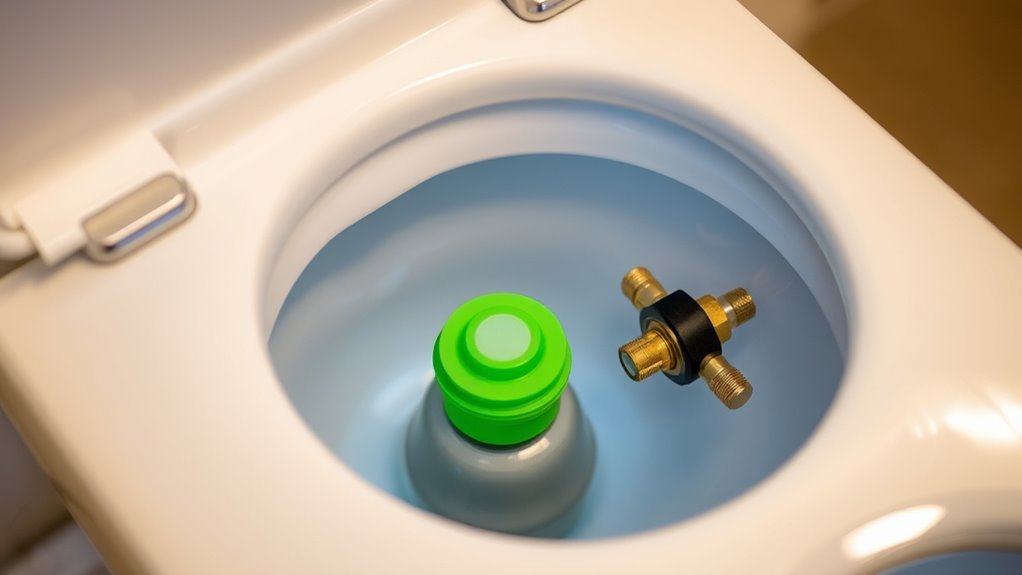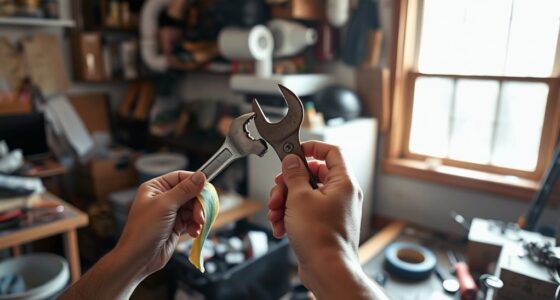To fix a running toilet quickly, start by shutting off the water supply and draining the tank. Remove the old flapper, which is often the culprit, and replace it with a new one costing about $3—easy to locate at any hardware store. Attach the chain with a slight slack and turn the water back on. If the issue persists, adjusting the float can help make sure the flapper seals properly. Keep going for more tips.
Key Takeaways
- Turn off the toilet’s water supply and drain the tank to access the flapper.
- Remove the faulty flapper from the flush valve and bring it to a hardware store for an exact $3 replacement.
- Install the new flapper by attaching it to the flush valve and connecting the chain with proper slack.
- Turn the water back on and adjust the float or fill valve to ensure the water stops at the correct level.
- This quick fix prevents continuous running, saves water, and is an affordable, do-it-yourself solution.

A running toilet can waste a significant amount of water and increase your utility bills, but fixing it is often simpler than you might think. The most common cause of a constantly running toilet is a faulty flapper. This small rubber part seals the tank and prevents water from flowing into the bowl until you flush. When it wears out or becomes misaligned, water leaks continuously, causing the toilet to run nonstop. Luckily, repairing or replacing the flapper is an inexpensive fix that you can do yourself in just a few minutes.
Start by turning off the water supply to your toilet. Usually, there’s a shut-off valve located behind or beside the toilet. Turn it clockwise until it stops. Then, flush the toilet to drain most of the water from the tank. If there’s still water remaining, use a sponge or towel to soak it up and clear the way for your repair. Now, lift the lid of the tank carefully so you can access the flapper.
Inspect the flapper for any signs of damage, warping, or buildup of mineral deposits. If it looks cracked, misshapen, or heavily stained, it’s time for a replacement. Even if it appears fine, sometimes a flapper can become warped or lose its flexibility over time, leading to leaks. To fix the issue, detach the old flapper from the chain and the flush valve. Remove it from the tank and take it to a hardware store to ensure you get an exact replacement, costing around $3.
Once you have the new flapper, install it by attaching it to the flush valve and reconnecting the chain. Adjust the chain length so there’s a slight slack when the flapper is closed—this helps ensure a proper seal. Now, turn the water back on by opening the shut-off valve. Let the tank fill up and observe whether the water stops running once the tank reaches the proper water level. An incorrectly set water level can cause the flapper to stay open or leak, so if the water keeps flowing, adjust the float or fill valve to set the correct water level.
This simple flapper repair and adjustment can stop your toilet from running in minutes, saving you water and money. If the problem persists, check the water level in the tank. It should be just below the opening of the overflow tube. If it’s too high, adjust the float to lower the water level, ensuring the flapper can seal properly. Fixing these issues yourself is quick, easy, and affordable, making your toilet efficient again without needing a plumber. Additionally, understanding how to properly tune your toilet components can prevent future issues and keep everything functioning smoothly.
Frequently Asked Questions
Can This Part Fix All Types of Running Toilets?
This part is a great solution for many running toilets, but it may not fix all types. For effective toilet repair, you need to identify the specific cause, like a faulty flapper or fill valve. While this $3 part often works for common issues, plumbing tips suggest checking your toilet’s model and mechanism first. If you’re unsure, consulting a professional guarantees your repair is successful and prevents future problems.
Is Professional Plumbing Help Necessary for Installation?
Imagine trying DIY plumbing for your toilet repair, wondering if you should call a pro. Usually, if you’re comfortable with basic tools, you can install the $3 part yourself, saving on labor costs. For straightforward fixes, professional help isn’t necessary, and you’ll see a better cost comparison. However, if your tank has complex issues or leaks, hiring a plumber might be the safer choice to avoid further damage.
How Long Does It Take to Install the Part?
The installation timeline for this $3 part is quick—you can typically complete the repair in about 10 to 15 minutes. You don’t need professional help, as it’s straightforward and designed for easy DIY. The repair duration depends on your familiarity with toilet parts, but most people find it simple to install without special tools. With a little effort, you’ll have your toilet running smoothly again in no time.
Will This Part Cause Any Damage to My Toilet?
When considering toilet repair, you’re probably wondering if this part could cause damage. Rest assured, if installed properly, it won’t harm your toilet. Using the right part enhances plumbing safety and ensures smooth operation. Follow the instructions carefully, and you’ll avoid issues. This simple fix is designed to be safe and effective, so there’s no need to worry about damage when you handle the repair correctly.
How Often Should I Replace This Part?
Think of toilet maintenance like tending a garden; you need to prune and replace parts to keep everything thriving. Typically, this $3 part lasts about a year, but frequent use or hard water can shorten its longevity. You should replace it whenever you notice signs of wear or the toilet keeps running. Regular checkups help prevent bigger issues, ensuring your toilet stays efficient and trouble-free.
Conclusion
With this simple $3 fix, you can quiet that stubborn toilet like a whisper in a library. Don’t let a running toilet turn your bathroom into a noisy chaos; instead, take control in just five minutes. Remember, sometimes the smallest parts hold the biggest solutions—like this tiny part that can save you from costly repairs and sleepless nights. So grab your tool, fix it now, and enjoy the peace of a perfectly functioning toilet, silent and smooth.









